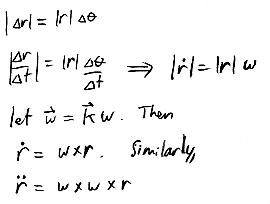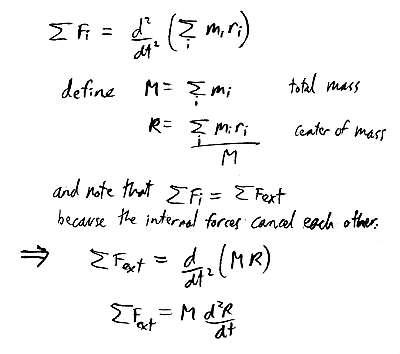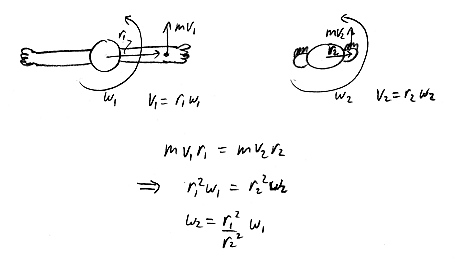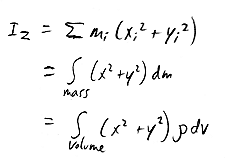Introduction to Rigid Body Dynamics
Preliminaries
Cross product review

-
a x a = 0
-
a x b is perpendicular to both a and b.

-
right hand rule: if the fingers are curled from a to b, the thumb points
in the direction of a x b
-
a x b as a matrix product:

-
note:
a x a = 0
a x b = - b x a
a x (b+c) = axb + axc

Kinematics of 2D rotation
-
determine the velocity and acceleration of a rotating point


Newton's 2nd law
-
linear momentum: P = m v
-
Newton's 2nd law:

-
conservation of linear momentum

-
inertial frame: a coordinate frame in which Newton's second
law holds
-
all intertial frames can be related to a universal frame
-
intertial frames do not accelerate or rotate with respect to the universal
frame
Center of mass
-
consider a rigid system of particles:

-
Newton's 2nd law applied to the individual particles:

-
Newton's 2nd law applied to the ensemble:

Rotation
-
intuition: torques are 'angular forces'

-
example: rotation about a fixed axis

-
computing work as being the product of force and distance:

-
re-express the work in terms of the product of torque and angle

-
geometry of computing torques

Angular Momentum
-
recall that the sum of forces equals the rate of change of linear momentum

-
similarly, the sum of torques equals the rate of change of angular momentum

-
consider one particle

-
consider a rigid system of particles

-
conservation of angular momentum

-
example 1: consider a planet with an elliptical orbit

-
example 2: figure skater

Moment of inertia
-
consider an object rotating about a fixed axis O:

-
revisiting the figure skater:

decreasing the moment of inertia increases the spinning speed
-
computing I

Kinetic Energy

-
for a body which is not rotating:

-
for a body which is only rotating:
































